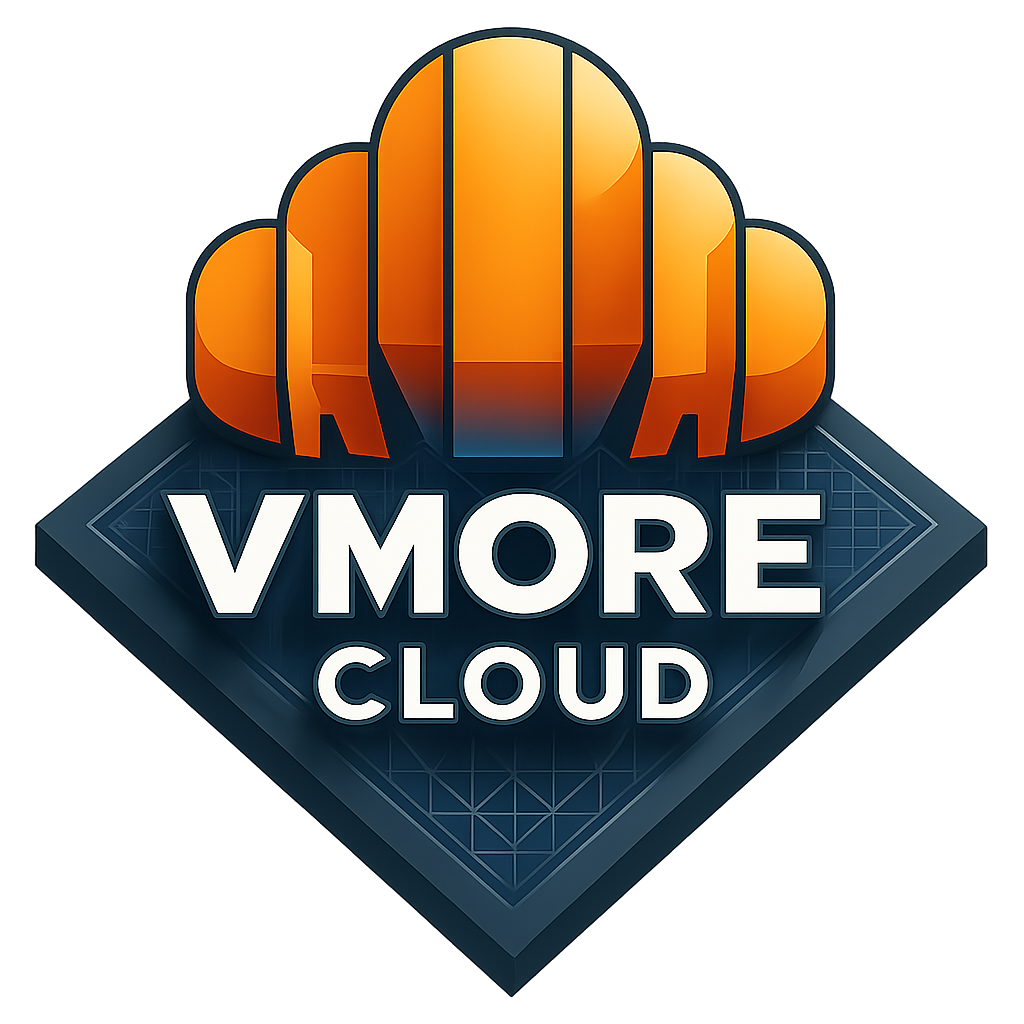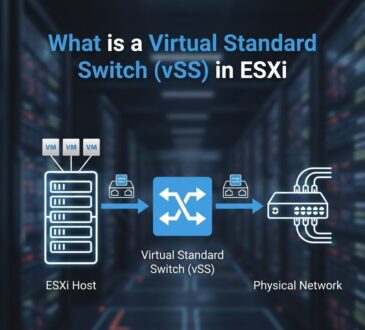
Tired of juggling multiple physical networks? Ready for a more efficient, cost-effective way to manage your network infrastructure? Network virtualization software is the answer.
In this blog post, we’re spotlighting the 7 best network virtualization tools of 2024—designed to enhance scalability, boost security, and simplify network management.
Whether you’re an IT expert or a business owner, read on to find the right solution to streamline your networking operations.
What is Network Virtualization?
Network virtualization involves creating a virtual version of a network, encompassing both its hardware and software components. It enables users to build, deploy, and manage networks within a virtual environment.This technology serves multiple purposes—such as testing new network architectures, simulating various network conditions, and training teams on emerging networking technologies.
By consolidating and streamlining network management, virtualization helps administrators oversee multiple networks more efficiently, leading to reduced costs and enhanced operational efficiency. It also boosts a network’s scalability, availability, and security.
Benefits of Using Network Virtualization Software
1. Increased Flexibility
Network virtualization software provides a high degree of flexibility, allowing you to easily change your network configuration without having to physically reconfigure your hardware. This can be a major advantage when you need to quickly respond to changes in your business environment or when you want to experiment with different network designs.
2. Improved Efficiency
Network virtualization can also improve the efficiency of your network by consolidating multiple physical devices into a single virtual device. This can reduce the amount of hardware you need to purchase and maintain, and it can also make it easier to manage your network since there are fewer devices to configure and monitor.
3. Enhanced Security
Another benefit of using network virtualization software is that it can help enhance the security of your network. By isolating each virtual device from the others, you can prevent one compromised device from affecting the others. Additionally, many virtualization platforms offer built-in security features, such as firewalls and intrusion detection systems, that can further protect your network.
7 Best Network Virtualization Software of 2024
As networking technology advances, more and more businesses are looking to adopt network virtualization software. This type of software allows businesses to create a virtual version of their network, which can be used to test out new configurations or ideas without affecting the live network.
DevOps
There are many different types of network virtualization software available on the market, so it can be difficult to know which one is right for your business. To help you make the best decision for your business, we have put together a list of the best network virtualization software of 2024.
1. VMware NSX
2. Check Point Virtual Systems
3. Cisco Enterprise NFV
4. Red Hat OpenStack Platform
5. oVirt
6. Vagrant
7. Juniper Networks vSRX Virtual Firewall
1. VMware NSX
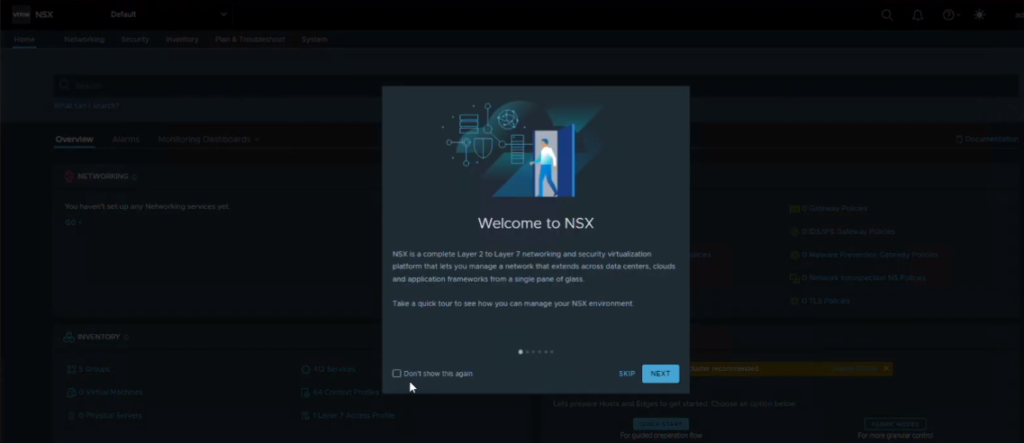
VMware NSX is a leading network virtualization platform that transforms traditional network infrastructure by decoupling networking functions from physical hardware. Leveraging server virtualization, NSX enables the creation of a Software-Defined Data Center (SDDC) that is more agile, scalable, and secure.
With NSX, organizations can rapidly provision new applications and services in minutes—eliminating the delays and expenses associated with physical hardware deployments. It also simplifies the enforcement of automated network security policies through distributed firewalls and micro-segmentation, effectively protecting applications from both internal and external threats.
NSX provides a unified management interface—a single pane of glass—for overseeing both virtual and physical network environments. IT teams gain deeper visibility into the infrastructure and can automate critical tasks like provisioning with just a few clicks, streamlining operations and boosting efficiency.
Features
- Streamline network management and provisioning
- Robust multisite networking and security capabilities.
- Proactive security measures against sophisticated cyber threats.
- Micro-segmentation and granular access controls.
- Comprehensive L2-L7 network stack and overlay services.
- Enforce security policies at the virtual machine level.
- Authorized users can connect securely from remote locations.
Pros
- Increased agility and scalability.
- Lower operational costs.
- Improved visibility and security.
- Faster service deployment.
- Multi-site network support.
- Ability to automate network operations.
Cons
- High upfront costs.
- Potential interoperability issues.
- The complexity of security policies.
Pricing
The cost of VMware NSX varies depending on the number of CPUs and the type of license you choose. The price for a perpetual license starts at $6,995 per CPU. The subscription-based model starts at $1,995 per CPU per year.
2. Check Point Virtual Systems
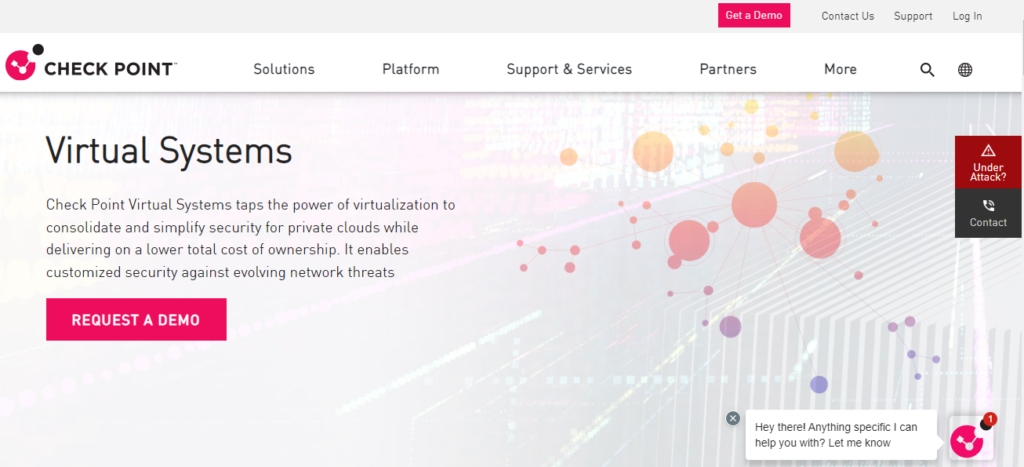
Check Point’s virtual systems deliver top-tier security and performance, making them an excellent choice for businesses seeking to enhance their network infrastructure.
These virtual systems provide all the advantages of virtualization without compromising on security or speed. Check Point’s innovative virtualization approach ensures each virtual system is securely isolated, so if one is breached, the others remain protected.
Highly scalable, Check Point virtual systems allow businesses to easily adjust resources to meet evolving demands—perfect for organizations experiencing growth or change.
Backed by world-class, 24/7 support via phone and online chat, Check Point ensures businesses have the assistance they need to maintain smooth, reliable network operations at all times.
Features
- Isolate each virtual system for added security and protection.
- Easily add or remove resources as needed.
- 24/7 phone support and online chat are available.
- Choose from a variety of features to customize your experience.
Pros
- Provide advanced security measures to protect network resources.
- Enables easy scalability where organizations can dynamically allocate resources and adjust the system’s capacity as per their needs.
- Simplifies and automates network virtualization processes.
- Empowers deployment of multiple virtualized security gateways on a single hardware device.
- User-friendly interface for easy configuration and platform usage.
- Establishes a single point of control for security policies across virtual and physical environments.
Cons
- New software versions of Check Point Virtual Systems can be resource-intensive.
Pricing
Contact Check Point Virtual Systems for Pricing.
3. Cisco Enterprise NFV
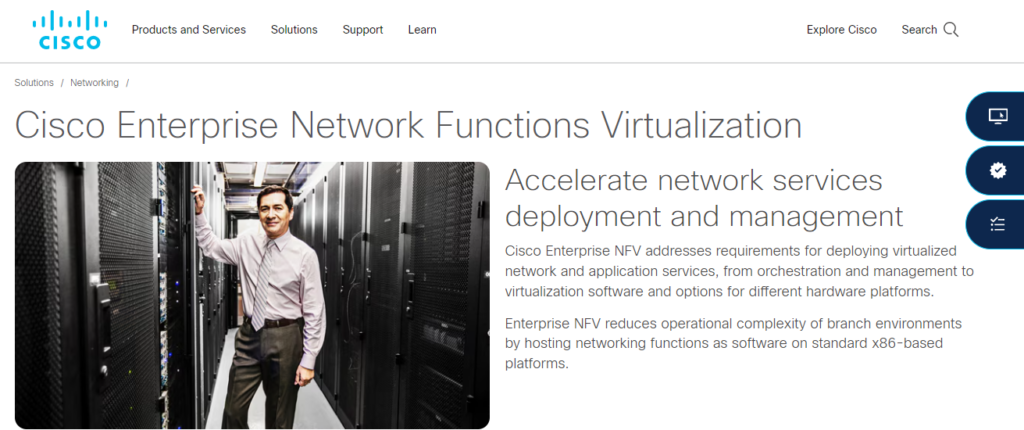
Cisco’s Enterprise NFV software empowers organizations to virtualize their network infrastructure and boost operational efficiency. It enables the creation and management of virtualized network functions—like routers, switches, and firewalls—within a single platform, reducing reliance on physical hardware and simplifying network scalability.
The software also offers advanced security features and performance monitoring to ensure reliable operations.
Available as a subscription-based service, Cisco Enterprise NFV includes access to cloud-based management tools such as Cisco’s Network Services Orchestrator. It supports flexible deployment options, including both on-premises and cloud environments.
Features
- Virtualization of network infrastructure
- Scalable and easy-to-manage platform
- Enhanced security and performance monitoring
- Cloud-based management tools (Network Services Orchestrator)
- On-premises and cloud-based deployment options
Pros
- Cost-effective solution for virtualizing network infrastructure
- Increased agility to scale and manage networks
- Improved security and performance monitoring capabilities
- Access to Cisco’s cloud-based management tools
Cons
- Limited scalability for larger organizations with complex network architectures
- High cost of subscription-based services
Pricing
Cisco Enterprise NFV is expected to be provided through the Cisco ONE WAN suite as an annual subscription. Cisco ONE Foundation offers list pricing starting at US $1200 for WAN and US $200 for Access. However, I would recommend you contact Cisco directly for more accurate pricing information as prices may vary depending on your specific needs and requirements.
4. Red Hat OpenStack Platform

Red Hat OpenStack Platform is the best virtualization software for revolutionizing your network infrastructure. It enables you to create a private cloud that is open, scalable, and secure. With the Red Hat OpenStack Platform, you can:
Cloud V9 certifications
- Build an Infrastructure as a Service (IaaS) cloud
- Provision and manage virtual machines and other resources
- Enable self-service provisioning for users
- Achieve high availability and scalability
Red Hat OpenStack Platform is based on the industry-leading Kernel-based Virtual Machine (KVM) hypervisor and provides a robust set of features for building a private cloud, including:
- A web-based management console for easy administration
- A command-line interface (CLI) for advanced configuration options
- APIs for integration with third-party tools and services
Features
- Support for application deployment and orchestration
- Support for Windows and Linux guest operating systems
- Security features to help protect your cloud environment
Pros
Easy to use: With an intuitive web-based management console, it’s easy to get up and running quickly.
Cloud V9 certifications
- Robust features: A wide range of features enable you to build a reliable and secure cloud environment.
- Flexible: Red Hat OpenStack Platform provides flexibility for scaling up or down as needed.
Cons
- Expensive: The Red Hat OpenStack Platform can be costly to set up and maintain due to the cost of licensing fees.
- Complexity: The platform can be complex to configure and manage, so it may require expert knowledge.
Pricing
Red Hat OpenStack Platform pricing depends on the edition you choose and the number of socket pairs you need.
- Red Hat Enterprise Linux OpenStack Platform for Controller Nodes Standard: $2,149/socket-pair/year
- Red Hat Enterprise Linux OpenStack Platform for Controller Nodes Premium: $2,799/socket-pair/year
- Red Hat Enterprise Linux OpenStack Platform Standard: $3,449/socket-pair/year
- Red Hat Enterprise Linux OpenStack Platform Premium: $4,499/socket-pair/year
5. oVirt
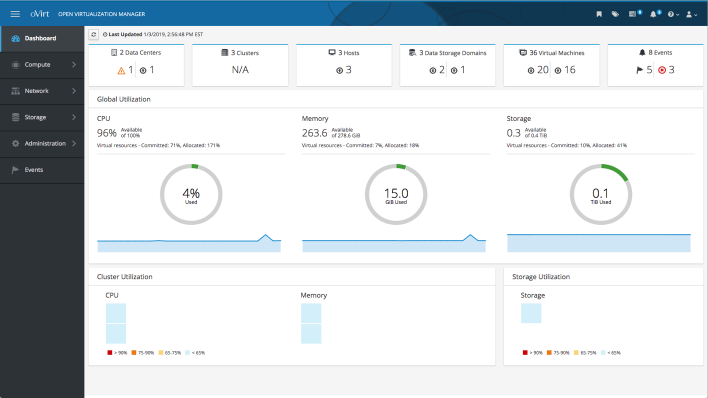
oVirt is a free and open-source virtualization software used to manage virtual machines and other virtualized resources. oVirt provides a web-based interface for managing virtual machines, storage, networks, and users. It also includes a command line interface and a REST API for automated management.
oVirt is based on the KVM hypervisor and is designed to be easy to install and manage. oVirt can be used to create and manage virtual machines, storage pools, and networking configurations. oVirt also provides a web-based interface for monitoring resource usage and performance statistics.
Features
oVirt provides a wide range of features to help manage virtualized resources. These include:
- Supports distributed storage for both file-based and block-level storage, providing high availability and scalability.
- Supports the creation of multiple networks, with different isolation levels and user access control.
- web interface allows users to easily create and manage virtual machines, allocate resources, and set up network configurations.
- Provides a dashboard that displays resource usage statistics such as CPU utilization, memory usage, disk I/O, and network traffic.
- Supports high availability by automatically migrating running virtual machines to other nodes in the cluster if one node fails.
Pros
- oVirt is an open-source virtualization platform that is free to use.
- It provides a web-based interface for managing virtual machines and hosts.
- oVirt supports multiple hypervisors including KVM, Xen, and VMware ESXi.
- It provides high availability and load-balancing features for virtual machines.
- oVirt supports live migration of virtual machines between hosts.
Cons
- oVirt requires a significant amount of resources to run efficiently.
- It can be difficult to set up and configure for new users.
- oVirt does not have as many features as some of its competitors such as VMware vSphere
Pricing
- According to Spiceworks, oVirt gives you enterprise-level functionality at $0.00 cost
6. Vagrant by HashiCorp
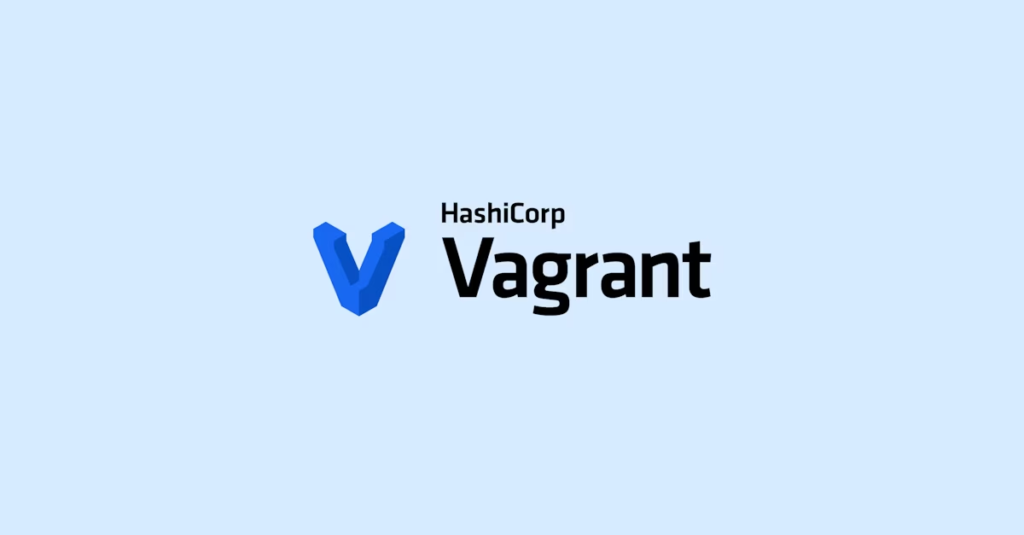
If you’re looking to transform your network infrastructure, Vagrant is an excellent choice. As one of the top virtualization tools available, Vagrant simplifies the creation and management of virtual machines, making it ideal for both development and production environments.
Key features of Vagrant include broad support for multiple operating systems, deployment automation, and containerization capabilities. It also allows for rapid scaling of your infrastructure, ensuring smooth and efficient operations.
With Vagrant, managing virtual machines becomes straightforward, freeing you from technical complexities so you can focus on driving your projects forward.
Features
- Automated deployment
- Cross-platform support
- Provisioning with Puppet, Chef, and Ansible
- Network and security configuration
- Containerization with Docker, LXC, and Vagrant boxes
- High availability and portability of applications
Pros
- Vagrant is designed for ease of use, allowing users to quickly spin up and configure virtual machines with minimal effort.
- Supports multiple operating systems, meaning you can deploy applications on multiple platforms without having to worry about compatibility issues.
- With Vagrant, you can automate the deployment process, ensuring that your infrastructure is properly configured and running efficiently.
- Vagrant makes it easy to scale up or down your infrastructure as needed, so you can always meet the demands of your business.
- Because Vagrant allows you to automate processes and quickly spin up new machines, it’s a cost-effective solution for businesses looking to save money on setup costs.
Cons
- Vagrant is not well suited for handling changes to infrastructure.
- It is most often used to create consistent development and testing VMs
Pricing
- Creating a Vagrant Cloud account enables you to create, share, and collaborate on Vagrant boxes2. The pricing for this service starts at $5/month for a private box
7. Juniper Networks vSRX Virtual Firewall
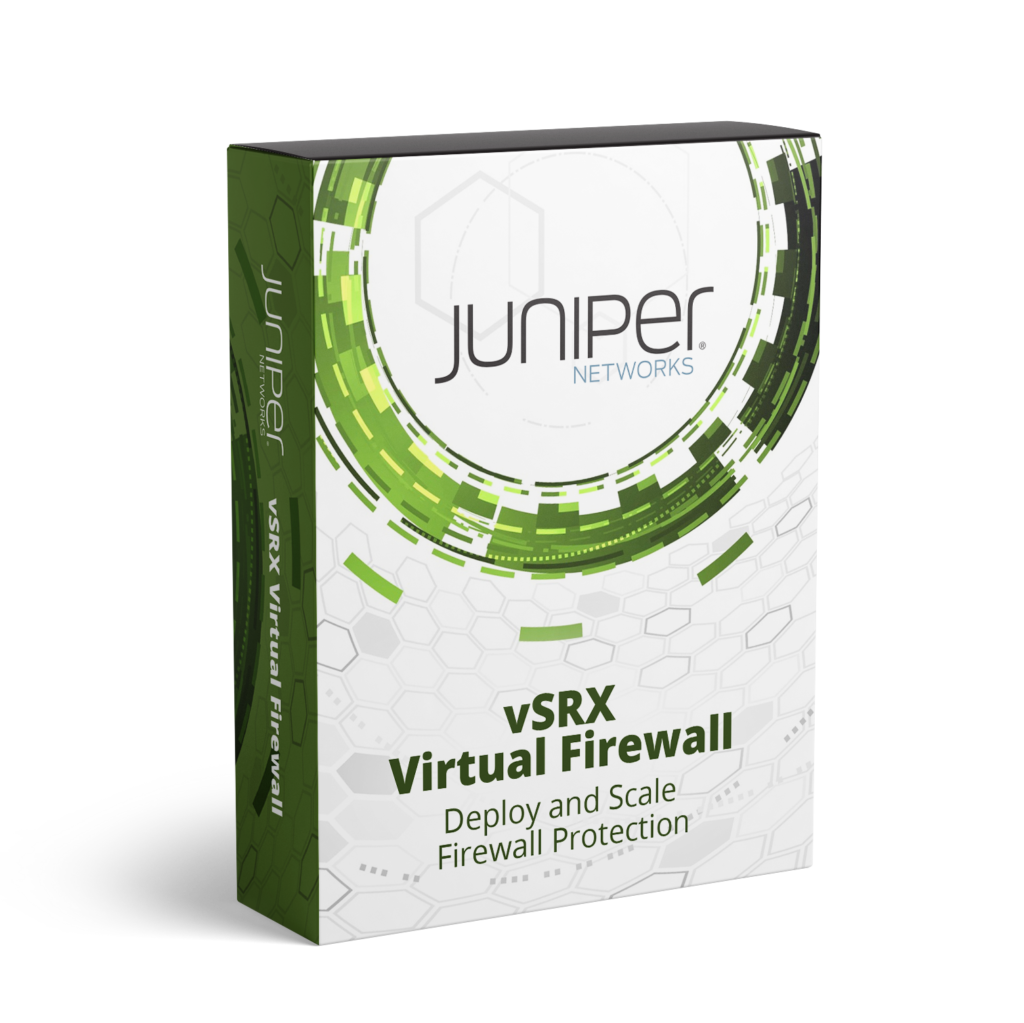
Juniper Networks vSRX Virtual Firewall is a leading network virtualization solution that delivers robust security, high performance, and scalability for data center and cloud environments. vSRX enables seamless deployment and management of virtual firewalls in complex infrastructures, safeguarding your data and applications with advanced protection.
Key features of vSRX include Application Identification, Intrusion Prevention, URL Filtering, and Advanced Threat Protection. It supports a wide range of virtualization platforms such as VMware vSphere, Microsoft Hyper-V, and KVM, ensuring flexible integration with your existing infrastructure.
With vSRX, you can confidently secure your network while maintaining agility and scalability.
- Application Identification, Intrusion Prevention, URL Filtering, and Advanced Threat Protection
- Supports multiple virtualization technologies such as VMware vSphere, Microsoft Hyper-V, and KVM
- Easy to deploy and manage virtual firewalls in complex environments
- Provides robust security features to protect your data and applications
Pros
- Easy to deploy and manage
- Comprehensive security, performance, and scalability for data center or cloud deployments
- Automated threat detection and prevention
- Supports multiple virtualization technologies
Cons
- Licensing can be expensive for large deployments
- Some features require additional licenses for full functionality
Pricing
Juniper Networks vSRX Virtual Firewall is available in multiple license options from $1,000 to $15,000. The pricing depends on the features you need and the number of virtual firewalls you want to deploy.
How to Choose the Best Network Virtualization Software?
Here are some tips to help you choose the best network virtualization software for your business:
Define your goals: What do you want to achieve with network virtualization? Do you want to improve resource utilization, reduce costs, or increase agility? Once you know what your goals are, you can narrow down your options.
Consider your budget: How much can you afford to spend on network virtualization software? There are many affordable options available, so don’t let cost be a deciding factor.
Evaluate your existing infrastructure: What type of hardware and software do you currently have in place? Make sure that the network virtualization software you select is compatible with your existing infrastructure.
Compare features and functionality: Not all network virtualization software is created equal—some products offer more features and functionality than others. Compare products side-by-side to find the one that best meets your needs.
Get expert advice: If you’re still not sure which product is right for you, seek out expert advice from someone who specializes in network virtualization. They can help you evaluate your options and make a decision.
- Design
